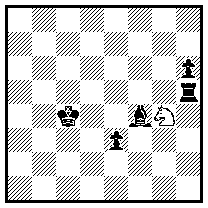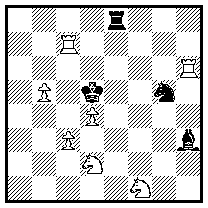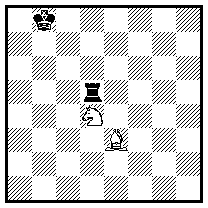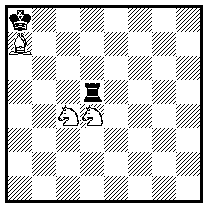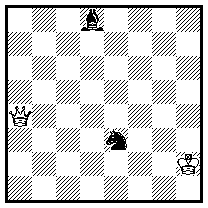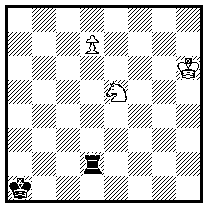8th World Chess Composing Tournament of the FIDE
All Questions and Answers
General note concerning WCCT Rules
The following is a (two part) question regarding twinning in Section G (fairies):
1. Is twinning (a) Anticirce type Calvet (b) Anticirce type Cheylan allowed?
2. Assuming a position with only 1 fairy unit on the board, say Lion e5, is
twinning (a) Lion e5 (b) Leo e5 allowed?Reply: According to paragraph 5 of the Rules, twinning is not allowed unless
otherwise specified (the Helpmates theme is such an exception). This rule
applies for every section of the WCCT.Remark: the clause "both Calvet and Cheylan Anti-circe types are permitted"
in theme G comes to mean that either Calvet or Cheylan is permitted.
Of course the same problem may comply with both, but both as twins
are not allowed.Important: Please note that the reply above has to do with the general
rules of the WCCT. All team captains, please make sure that you and your country’s
composers are aware of the general rules of the 8th
WCCT.
Section A
a) Scheme:
White: Sg4; Black: Kc4; Rh5; Bf4; Pe3, Ph6.
Variations (in real solution):
1…B~ 2.Sxe3#
1…Bg5 2.Se5#
In the framework of the #2 theme, is the play above thematic? In other words,
is the move 1…Bg5 regarded as Correction?Reply: Yes, it is a correction. One of the examples is of the same kind.
b) In example 4, the thematic variations appearing in the real solution
already exist in set play (it is the only example like this). Is it allowed?
The theme definition says nothing on that.Reply: Yes, it is allowed.
c) Is there any example on how could a random move be an interference
(the last mentioned case)? Does it mean the correction move must also be another
interference of the same black line, as we got used to see in the Correction
of the third degree?Reply: See example below. The correction-move must interfere with the same
black line, but the resulting mate does not have to use this interference.Sketch:
#2
Threat: 2.Rc5#
1…Se4 (a random interference) 2.Se3#
1…Se6! (a correction) 2.Rd7#
d) Some named themes in their basic forms (Vladimirov, Banny, Dombrovskis,
Hannelius, etc.) ask for two thematic refutations. Does it mean that random
move (1…F~) in 8. WCCT should be treated as an absolutely normal (not as
inferior, as usually) refutation?Reply: The theme does not specify the nature of the refutation. It is the
judges’ duty to consider if a double/multiple/random-move refutation is justified
within a given problem.e) Some problemists accept Black correction only if there are two or more
moves (not only one!) representing random move (in the common definition of
taking a piece away from some field). Should only one possible move in this
case be treated as an absolutely normal random move, not as inferior or less
thematic one?Reply: It is allowed for a single move to represent a random move. It is
the judges’ duty to assess its necessity within a given problem or whether
it creates any disturbance.f) Is a #2 thematic where two different random defences exist of the same
black piece (for example: a horizontal random rook move, a vertical random
rook move, and then correction moves by this rook)? If yes: Is it necessary
that each random move is answered by a thematic white move?Reply: Yes, these two types of random moves by the same black piece are allowed,
but if both are to be considered thematic then each of them should be answered
by a thematic white move (including an answer to each one’s correction move).
If only one of the types of random moves is answered by a thematic white move
(including the answer to its correction move) then this one alone could be
considered thematic.
Section B
Can a black Pawn be a thematic unit? The definition says: "…pinning
a black piece…" What about Pawns?Reply: Yes, a Pawn may be a thematic piece.
Section C
Is a switchback of a promoted piece to a square where the pawn (before
its promotion) has been (e.g. 2.c7-c8=Q … 4.Qc7) considered thematic?Reply: Yes, it is.
An important notice:
Your attention is required for a change in interpretation concerning the Studies
theme. This change is considered necessary to remove the confusion created
by the old interpretation. Apologies for any inconvenience this might cause.According to the new interpretation, if an attacked
piece is also guarded, the subsequent elimination of this guard (by interference,
capture, withdrawal, pin, etc.) cannot by itself be considered thematic.Hopefully, this will simplify things and make them more congruent with intuitive
understanding of the theme.a) In example 4 (Sobolevski), after 2.Rd6 Rb5 the hypothetical move 3.Rb6(?)
would be thematic?Reply: No.
b) In position w. Bc5 Sd4 – b. Rd8 after 1…Rd5 (Bc5 en-prise) the move
2.Sf5 is thematic?Reply: Yes.
c) In position w. Bc5 Sb3 Sg4 – b. Re5 after 1…Rg5 (Sg4 en-prise) the
move 2.Sd2 (Bc5 en-prise) is thematic?Reply: (New!): No, the removal of a guard
per-se is not thematic.d) In the position:
White: Be3 Sd4; Black: Kb8 Rd5 – is the sequence 1.Bf4+ Ka7 2.Bd6 thematic?
Reply: (New!): This sequence is not thematic
for several reasons:1. The first piece to be attacked must become attacked by the move of a piece
of the opposite camp;2. A removal of a guard cannot, by itself, be considered thematic.
e) In the position:
White: Ba7 Sc4 Sd4; Black: Ka8 Rd5 – is the sequence 1…Kxa7 2.Sd6 thematic?
Reply: (New!): No, it isn’t. An elimination
of a guard cannot, by itself, be considered thematic.f) In the position:
White: Kh2 Qa4; Black: Bd8 Se3 – is 1.Qf4 Bc7 thematic?
Reply: No, it is not. 1…Bc7 renders 2.Qxd3 illegal, and so only one black
piece is attacked instead of the required two.g) In the position:
White: Kh6 Se5 Pd7; Black: Ka1 Rd2 – is the play 1…Rd5 2.d8Q thematic? A
pawn has been moving but a queen is en-prise…Reply: (New!): Yes, this is thematic (even if
Pd7 is unprotected). An attacked Pawn is irrelevant, whereas the sacrifice
of a promoted Queen is thematically relevant.g) Diagram:
White: Re8, Sd1 / Black: Sf6, Sf4, Be2
1) Is the move 1.Re4, thematic?
Reply: (New!): This move puts Re4 under attack in a position where Sd1 is also being attacked, so it would be thematic in one condition: it must have occurred immediately after the black attack of Sd1. As an attack of Sf4 it would become thematic only after Black puts another piece en-prise immediately, e.g. by playing 1…Se8.
2) If 1.Re4:
2a) is it thematic even if it is the first move in the study?
Reply (New!): No it isn’t. Even if it had
been possible to prove, by retrograde analysis, that Be2 was the last move,
it would have still been insufficient: this move has to occur in the post-diagram
position and not in a retro phase.2b) if it is the first move in the study, does it reduce the value of
the study?Reply: See 2a.
h) In the position:
White: Sb3 Sc4 Rf3; Black: Bd5 Se4 – is the sequence 1…Sd6 2.Se3 thematic?
Yes, it is thematic. A discovered attack (1…Sd6, exposing Rf3 to an attack from Bd5) and a discovered sacrifice (2.Se3, exposing Sb3 to an attack from Bd5) are allowed.
i) In a study with two variations or a main solution and a try, is it
enough for the thematic requirements to occur on any of these phases?Reply: For the study to be thematic, at least one line of the actual solution
must show the theme.
j) Position:
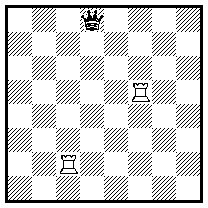
White: Rc2 Rf5; Black: Qd8
Is the sequence 1…Qd3 2.Rd5/Rf3 thematic?
Reply: Nothing in the theme definition formally forbids this sequence from being thematic; but there is a certain risk involved here, in that the judges might perceive the "sacrifice" of an already attacked piece as somewhat contrary to the spirit of the theme.
k) Can pieces A and B be used more than once to make thematic moves?
Reply: Of course, they can (but be careful – see announcement, example
4).l) In the position White: Ke8, Se6, Sg3 / Black: Ra5, is the sequence
1…Re5 2.Se2 thematic? (Can Se6 be pinned?)Reply: Yes, it can.
m) In the position White: Bc2, Sf6 / Black: Ra6, is the sequence 1…Rd6
2.Bd3 thematic? (Does the rook move constitute a new attack on Sf6?)Reply: Attacking a piece that is already en-prise looks inconsistent with
the spirit of the theme.n) Can a response to a check-giving move be quiet?
Reply: Yes, it can.
Section E
After first publication, the definition was changed (a) to clarify that the
mate occurs on the vacated square, and (b) to exclude the black King as thematic
vacating-piece.a) Is it acceptable here H#2.5 besides H#3? The idea can be shown even
in H#2, so a H#2.5 will have no impact on the thematic requirement.Reply: H#2.5 is not allowed.
b) If the black thematic piece moves more than once in a solution, the
requirement is fulfilled, but the strategy may have nothing to do with the
samples given. What is the intention here: to keep the requirement regardless
of what strategy may result, or to keep the strategic spirit of the given
examples, even if the requirement doesn’t ask for it?Sample illustration:
H#3 (2+5)
Ke5 Rb4 – Kc5 Rc7 Sb6 Pb5 d7
1.Ra7 Rd4 2.Ra4 R:d7 3.Rb4 Rc7
Reply: As long as the composer fulfills the theme requirement, he is free
to use whatever strategy he chooses. The example is a legitimate rendering
of the theme.c) Is a mate with double check allowed?
Reply: No, it isn’t.
d) Is capturing on the mating move allowed?
Reply: Yes, it is allowed.
e) Is it allowed for the same or other black piece to enter the vacated
square? For example, is the following problem thematic?J.-M. Loustau & J. Rotenberg
Prize, diagrammes 1992
h#3 (4+10)
White: Kb1 Rf6 Be6 Pd4
Black: Ke4 Qf7 Re8 Se7g6 Pg7c6d6g5g4
1.Qf8 Bg8 2.Qf7 Rf4+ 3.Kd5 Bxf7#
1.Qg8 Rf8 2.Qf7 Bd5+ 3.Kf5 Rxf7#
Reply: Yes, it is allowed. The example is thematic.
f) Is DUPLEX permitted (considering that the announcement says that all
kinds of twins are permitted)?Reply: Yes, Duplex is permitted.
g) Is a set play which fulfils the condition considered to be thematic?
Reply: Yes, it is.
Section F
a) Some problemists consider black dual in mating move as a serious weakness;
others accept it as normal in S#. Do judges have right to lower their mark
more than 0,5 points for such a subjective reason?Reply: The so called "black dual" on the mating move SHOULD NOT automatically
be considered a weakness. A "black dual" on the mating move might represent
an interesting variety, like any variation in Black’s play in reply to a white
move. It is the judges’ duty to evaluate in each particular case if (and to
what extent) such a "black dual" adds to, decreases from, or has no influence
on the problem’s value.b) Are virtual lines considered thematic?
For example: In the 1st black move, a white piece is captured. After this
capture, a white line-piece can NOT move onto a square which is located (either
orthogonally or diagonally) behind the black thematic piece, because after
a 2nd move of this black piece, a line would be emerging which would cause
a damage.Reply: Yes, "virtual" lines of this kind are considered thematic.
Section G
a) Is there a limit on the number of fairy pieces on the diagram? Is this
number connected in any way to the number of pawns?Reply: No limitation is imposed on the number of fairy pieces. This number
has no connection to the number of pawns. No proof-game is needed.b) What are the minimal thematic requirements for the problem (or is it
enough to have the theme in a single by-variation of an insignificant phase)?Reply: "Clash of rebirth" is the minimum requirement. Nothing forbids the
occurrence of the theme in "a single by-variation of an insignificant phase",
but there is no guarantee for the result…c) Is it possible to have more orthodox pieces on the diagram than the
pieces "in the box", e.g. 2 white Queens, 3 black Rooks etc.?Reply: Yes, the number of orthodox as well as fairy pieces, is unrestricted.
Full freedom is allowed in this respect, e.g. the number of pawns for each
side may exceed 8.d) May the number of pieces for each side exceed 16?
Reply: Yes, it may.
Invitation
| Introduction by the WCCT Subcommittee
| Themes | Rules
| List of registrations






